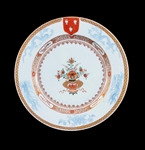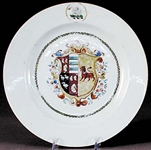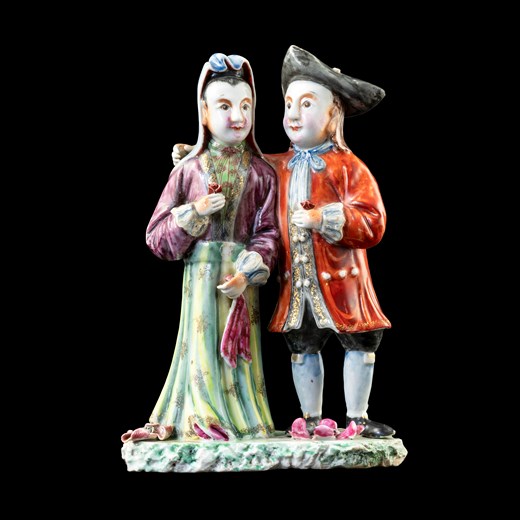What are you looking for?
searchChinese Armorial Charger, arms of Fazakerley
Chinese Armorial Charger, arms of Fazakerley
Yongzheng circa 1723$7500
Yongzheng period circa 1723
English Market
Diameter: 14¼ inches; 36cm
from the Golden Gate Collection, GG959
Priced in US dollars
$7,500
This item is located in the USA in the state of California. Shipping from there is at the buyer's expense. Please enquire if you would like to know more.
A Chinese export porcelain armorial charger with the coat of arms at the rim, the centre with a vase of flowers in famille verte enamels, the cavetto and rim with several borders in iron red and gilt.
The arms are for Fazakerley of Kirkby, near Liverpool. Lancashire. The arms of the main branch of the family, Fazakerley of Fazakerley, are very different. These arms were not formally Registered at the College of Arms until 1720 for William Fazakerley of Kirkby.
This rare service was ordered by William Fazakerley who was a supercargo in the East India Company and in Canton from 1723. His account for some of this period has survived:
He leaves London in December 1722, as Chief Supercargo for a fleet of four ships (the Duke of Cambridge, the Hartford, the Princess Anne and the Mountague). The ships are separated on the west coast of Africa but reunite on reaching Cape of Good Hope in March 1723, then sail on to Java by June, arriving at the Boca Tygris in mid-July. On 19 July he transfers to the ‘Factory’ (English Hong) on the Canton waterfront.
On 1st September 1723, a contract is agreed with the merchant Suqua for china-ware, though it is not clear if this was part of that contract. He was mainly dealing with purchasing Bohea tea and was concerned at being cheated with old leaf mixed with new. He notes with satisfaction that the Ostend Company have fared much worse with inferior tea.
On 20 October he writes that news was received that one of the boats transferring China-ware to the Hartford was sunk; “we were afraid of some Damage seeing several of the chests turn’d upside down”. However it seems they were able to recover most of it. Had he just ordered some of this armorial porcelain from Suqua it would have taken much longer to reach him as the order would, of course, had to go all the way to Jingdezhen, and then the porcelain brought back the 500 miles to Canton.
On 10 January 1724 he is in negotiation with the Hoppo for a pilot to oversee their departure but the Hoppo has been made aware of a handsome clock on one of the ships that he would like to send to the Emperor as a present. The Hoppo remains intransigent and the clock is duly surrendered to prevent “great delays we could not afford”.
By this time, his armorial porcelain could have arrived from Canton and, when they leave on the 21st January, be packed with Fazakerley’s private goods on board ship. The account ends at sea.
Fazakerley returned to Canton and by 1728 was in charge of the English trade there. His association with Suaqua continued, the latter having been in control of the green tea and woven silk trades for some years. In 1730 Fazakerley awarded him two thirds of the EIC contracts. However a rival of Suqua, Ton Hunqua, reported to the EIC in London that Fazakerley, James Naish and Suqua had colluded to defraud the Company. Suqua was removed and Ton Hunqua given the main trade. Naish and Fazakerley were subject to an investigation.
In 1732 Ton Hunqua was arrested by the new Hoppo, an ally of Sunqua. The Company resisted this, removed the Hoppo and restored Ton Hunqua, arresting Sunqua. However by 1735 when a Royal Commission had arrived in Canton to complete the fraud investigation into Fazakerley, nobody, not even Ton Hunqua would testify. Sunqua was released and resumed his trade. Fazakerley had returned to London by then and the case was never proved.
It is not clear what happened to William after that but he seems not to have married and the Fazakerley property in Kirkby had been sold. It is likely that he left his estate to his cousin Nicholas Fazakerley MP for Preston, who died in 1767 and who ordered a service which had the original Fazakerley arms quartered with these arms with the three heads. Nicholas married Ann Lutwyche whose arms are impaled with his - see image here (Howard 1974, p352).
References: Litzenburg 2003, p88, a dish the same as this; Howard 1974, p352; Howard 1994, cat 28 & 268, two services with the same design but different arms; Howard 1997, cat 117; Howard 2003, p147, this service and similar one with just the crest of a swan at the rim, also for Fazakerley; Chong 1997, pp46, 61, 137.
You may also like
Massive Chinese export punchbowl for the American market with a view of New York
Jiaqing period circa 1804$40000
Pair of large Chinese armorial porcelain Monteiths with the arms of Pinto Pereira
Yongzheng period circa 1735£60000










